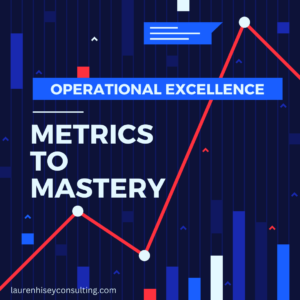Setting the Stage
- Use the DMAIC Framework
- Benchmarking
- Setting Targets

Unlocking Operational Excellence: Metrics to Mastery
As we continue into 2024, organizations strive for excellence, efficiency, and continuous improvement. Lean Six Sigma is a robust methodology that has emerged as a beacon for achieving these goals. But how do we measure its impact? How do we move beyond mere metrics and delve into mastery? This blog post explores the symbiotic relationship between Lean Six Sigma and organizational success, backed by quantifiable data and real-world examples. We learn how to move from metrics to mastery for operational excellence.
The Role of Metrics
Metrics—those numerical indicators that quantify performance—are the starting point. They provide us with a snapshot of where we stand. But they are more than just numbers; they tell a story. We gain insights into our organizational health when we track key performance indicators (KPIs) related to process efficiency, defect rates, cycle times, and customer satisfaction. These metrics serve as signposts, guiding us toward improvement opportunities.
Setting the Stage for Mastery
Imagine a chess player meticulously analyzing each move, anticipating the opponent’s strategy, an opponent’s checkmate. Similarly, Lean Six Sigma practitioners analyze KPIs to strategize their moves. But the endgame isn’t just about winning individual matches but mastering them. Here’s how we bridge the metrics to mastery:
- Understanding the DMAIC Framework: The Define-Measure-Analyze-Improve-Control (DMAIC) framework is the cornerstone of Lean Six Sigma. It provides structure and discipline. As we evaluate metrics, we align them with each phase of DMAIC. For instance:
- Define: Clearly define project goals and objectives. What success looks like matters.
- Measure: Collect relevant data and establish baseline metrics.
- Analyze: Dive deep into the data. Identify patterns, root causes, and improvement opportunities.
- Improve: Implement solutions and track progress against KPIs.
- Control: Sustain gains and prevent backsliding.
- Benchmarking and Targets: Metrics become meaningful when we compare them to industry benchmarks or best practices. Setting ambitious yet achievable targets propels us toward mastery. It’s not just about meeting the standard; it’s about exceeding it.
- Holistic View: Mastery involves seeing the big picture. Metrics alone won’t suffice. We must wonder about the interplay of processes, people, and culture. How does Lean Six Sigma influence collaboration, employee engagement, and customer loyalty? These intangibles matter.
Real-World Impact
Let’s step out of the Let’s into the real world. Consider a retail company that implemented Lean Six Sigma principles. Their defect rate dropped by 30%, resulting in cost savings and improved customer satisfaction. But that’s not all—employees embraced problem-solving techniques, fostering a culture of continuous improvement. The metrics were impressive, but the mastery lay in the transformed mindset.
Conclusion
Let’s move beyond the surface-level metrics to evaluate Lean Six Sigma’s impact. Let’s seek mastery to orchestrate change, inspire teams, and elevate organizational performance. From metrics to mastery, the journey is both quantitative and qualitative. So, fellow practitioners, let’s play the game strlet’scally, aiming not just for checkmate but for lasting influence.
Ready to learn how to apply Lean Six Sigma to your organization?
Let’s set up some to taLet’srther.
Follow us on LinkedIn.
Leave a Reply